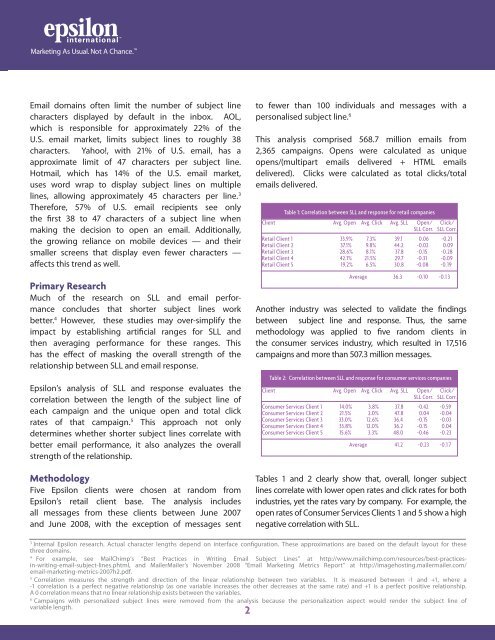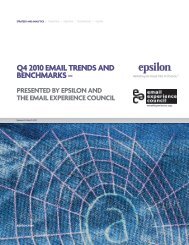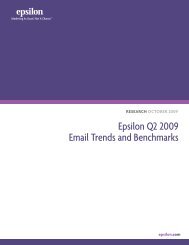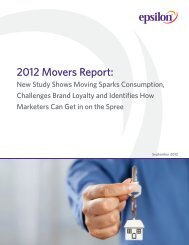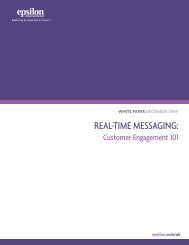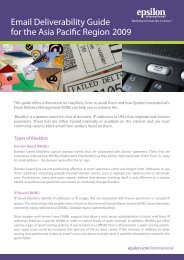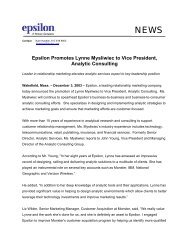Rethinking the Relationship between Subject Line Length ... - Epsilon
Rethinking the Relationship between Subject Line Length ... - Epsilon
Rethinking the Relationship between Subject Line Length ... - Epsilon
Create successful ePaper yourself
Turn your PDF publications into a flip-book with our unique Google optimized e-Paper software.
Email domains often limit <strong>the</strong> number of subject linecharacters displayed by default in <strong>the</strong> inbox. AOL,which is responsible for approximately 22% of <strong>the</strong>U.S. email market, limits subject lines to roughly 38characters. Yahoo!, with 21% of U.S. email, has aapproximate limit of 47 characters per subject line.Hotmail, which has 14% of <strong>the</strong> U.S. email market,uses word wrap to display subject lines on multiplelines, allowing approximately 45 characters per line. 3Therefore, 57% of U.S. email recipients see only<strong>the</strong> first 38 to 47 characters of a subject line whenmaking <strong>the</strong> decision to open an email. Additionally,<strong>the</strong> growing reliance on mobile devices — and <strong>the</strong>irsmaller screens that display even fewer characters —affects this trend as well.Primary ResearchMuch of <strong>the</strong> research on SLL and email performanceconcludes that shorter subject lines workbetter. 4 However, <strong>the</strong>se studies may over-simplify <strong>the</strong>impact by establishing artificial ranges for SLL and<strong>the</strong>n averaging performance for <strong>the</strong>se ranges. Thishas <strong>the</strong> effect of masking <strong>the</strong> overall strength of <strong>the</strong>relationship <strong>between</strong> SLL and email response.<strong>Epsilon</strong>’s analysis of SLL and response evaluates <strong>the</strong>correlation <strong>between</strong> <strong>the</strong> length of <strong>the</strong> subject line ofeach campaign and <strong>the</strong> unique open and total clickrates of that campaign. 5 This approach not onlydetermines whe<strong>the</strong>r shorter subject lines correlate withbetter email performance, it also analyzes <strong>the</strong> overallstrength of <strong>the</strong> relationship.MethodologyFive <strong>Epsilon</strong> clients were chosen at random from<strong>Epsilon</strong>’s retail client base. The analysis includesall messages from <strong>the</strong>se clients <strong>between</strong> June 2007and June 2008, with <strong>the</strong> exception of messages sentto fewer than 100 individuals and messages with apersonalised subject line. 6This analysis comprised 568.7 million emails from2,365 campaigns. Opens were calculated as uniqueopens/(multipart emails delivered + HTML emailsdelivered). Clicks were calculated as total clicks/totalemails delivered.Table 1: Correlation <strong>between</strong> SLL and response for retail companiesClient Avg. Open Avg. Click Avg. SLL Open/ Click/SLL Corr. SLL Corr.Retail Client 1 33.9% 7.3% 39.1 0.06 -0.21Retail Client 2 37.1% 9.8% 44.2 -0.02 0.09Retail Client 3 28.6% 8.1% 37.8 -0.15 -0.28Retail Client 4 42.1% 21.5% 29.7 -0.31 -0.09Retail Client 5 19.2% 6.5% 30.8 -0.08 -0.19Average 36.3 -0.10 -0.1 3Ano<strong>the</strong>r industry was selected to validate <strong>the</strong> findings<strong>between</strong> subject line and response. Thus, <strong>the</strong> samemethodology was applied to five random clients in<strong>the</strong> consumer services industry, which resulted in 17,516campaigns and more than 507.3 million messages.Table 2: Correlation <strong>between</strong> SLL and response for consumer services companiesClient Avg. Open Avg. Click Avg. SLL Open/ Click/SLL Corr. SLL Corr.Consumer Services Client 1 14.0% 3.8% 37.8 -0.42 -0.59Consumer Services Client 2 21.5% 2.0% 47.8 0.04 -0.04Consumer Services Client 3 33.0% 12.6% 36.4 -0.15 -0.03Consumer Services Client 4 33.8% 12.0% 36.2 -0.15 0.04Consumer Services Client 5 15.6% 3.3% 48.0 -0.46 -0.23Average 41.2 -0.23 -0.1 7Tables 1 and 2 clearly show that, overall, longer subjectlines correlate with lower open rates and click rates for bothindustries, yet <strong>the</strong> rates vary by company. For example, <strong>the</strong>open rates of Consumer Services Clients 1 and 5 show a highnegative correlation with SLL.3Internal <strong>Epsilon</strong> research. Actual character lengths depend on interface configuration. These approximations are based on <strong>the</strong> default layout for <strong>the</strong>sethree domains.4For example, see MailChimp’s “Best Practices in Writing Email <strong>Subject</strong> <strong>Line</strong>s” at http://www.mailchimp.com/resources/best-practicesin-writing-email-subject-lines.phtml,and MailerMailer’s November 2008 “Email Marketing Metrics Report” at http://imagehosting.mailermailer.com/email-marketing-metrics-2007h2.pdf.5Correlation measures <strong>the</strong> strength and direction of <strong>the</strong> linear relationship <strong>between</strong> two variables. It is measured <strong>between</strong> -1 and +1, where a-1 correlation is a perfect negative relationship (as one variable increases <strong>the</strong> o<strong>the</strong>r decreases at <strong>the</strong> same rate) and +1 is a perfect positive relationship.A 0 correlation means that no linear relationship exists <strong>between</strong> <strong>the</strong> variables. .6Campaigns with personalized subject lines were removed from <strong>the</strong> analysis because <strong>the</strong> personalization aspect would render <strong>the</strong> subject line ofvariable length.2


